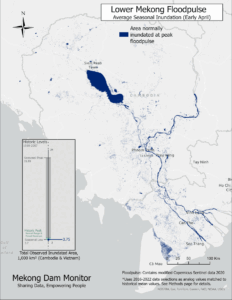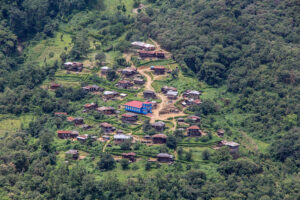Tangible Impact
Just six months after launching, the Mekong Dam Monitor is making significant advances in transparency and risk reduction in the Mekong Basin. For example, on May 28 we detected a 1.3 meter change in river level that was caused by a sudden water restriction at the Jinghong Dam, the most downstream of China’s 11 dams on the Mekong mainstream. We issued an alert to our network of local communities, media, and government stakeholders, giving them about 48 hours to prepare. Thailand’s National Water Command Center issued their own alert about five hours later, citing the Mekong Dam Monitor. The alert was also highlighted in a Bangkok Post article. This communications network has been built over the last six months through a high-touch, consultative process with stakeholders throughout the Mekong Basin, each of whom benefit from knowing what’s coming downstream. With near-real time reporting to vulnerable communities and governments, we are building a more transparent Mekong. And after scores of interactions with stakeholders, many individuals — from fishers in local communities to decision makers in government — are now able to interpret MDM data and the Eyes on Earth’s wetness measurement data it uses to significantly improve their understanding of the current, past, and future conditions of the Mekong Basin.
Transparency Creates an Opportunity for Improvement
After Stimson and Eyes on Earth partnered to promote the results of the April 2020 Eyes on Earth study, we received valuable suggestions and constructive criticism on how we could improve the effectiveness of our communications and data provision. It was clear that more effort was required to socialize Eyes on Earth’s wetness measurement data products and build an understanding of their utility and limitations.
Open Data and the Case of the Missing Water
Nonetheless, researchers monitoring conditions throughout the Mekong Basin, including the Mekong River Commission and universities, continued to share concerns about the output of Eyes on Earth’s natural flow model, which provides data on how much water would be present in the river if there were no dams impacting flow. In short, the model was showing more water “missing” from the river than should have been possible. In particular, a blog post authored by Aalto University researchers pointed to the excess water in the natural flow model as being too large when compared against the MRC gauge data. We actively reached out to those stakeholders to learn more about these concerns.
As the project team reviewed the data together, we also discovered the data showed an increasing deficit of water in China beyond the cumulative volume of what dams in China could hold. This set us on a 12 month project to “find the missing water”. We engaged numerous remote sensing and Mekong River experts from NASA, Stanford, University of North Carolina, the Mekong River Commission, and many others in this quest. These volunteers helped us sift through possible sources of the missing water. Many of these colleagues now sit on the Mekong Dam Monitor’s advisory council.
Considering our options
Together we ruled out inter-basin diversion (which from the beginning was never seriously considered) and potential effects of irrigation schemes, which are likely measurable but could not account for the missing water. We also considered permanent loss of water through reservoir evaporation. Using a proxy comparison to similarly large reservoirs in major US river basins located in similar climatic zones, we determined that reservoir evaporation could lead to losses of up to two cubic kilometers of water per year. But none of this could account for the majority of missing water.
A problem 500 miles up
The Eyes on Earth team then took a hard look at drift in the overpass time of the satellites that collect the data they use. Multiple Defense Meteorological Satellites use the same SSM/I sensor array to collect meteorological data and Eyes on Earth was using an average of morning and afternoon satellite passes to generate their wetness product data, which are then fed into the Natural Flow Model algorithm used in the Mekong Dam Monitor. The Eyes on Earth team noticed a growing difference between values collected during morning satellite passes compared to afternoon satellites as the time of the morning pass slowly drifted – over years – earlier and earlier in the morning. Daily data between the two morning and afternoon satellite passes should not significantly differ, but the data showed a growing discrepancy.
Better input = Better output
After testing the effects of the discrepancy between morning and afternoon satellite data on the flow model, the Eyes on Earth team concluded that the shifting overpass time was producing bias in the input data from the SSMI satellite morning passes. To correct the problem, the Eyes on Earth team is now only using afternoon satellite passes for input data to their natural flow model. Better data into the model means better outputs. Eyes on Earth has a deep dive into the technical details of this discovery and adjustment on their website.
What does this mean? Advancement in science happens through progressive steps, and we’ve learned much from our user community over the past year. By identifying the issue with the input data, we have improved the accuracy of a product that is built on a foundation of transparency and openness. The growing increase of water once shown in the natural flow model has been identified and corrected – the remaining deficit is a more accurate picture of how much water is permanently stored behind reservoir walls throughout the basin. We can now see that upstream releases during the dry season roughly equal upstream water restrictions during the Mekong’s wet season. And we can better analyze the effects of upstream regulation of dams and better see their impacts — particularly in the upper basin — in near-real time.
Assessing past work with a more accurate model
The result of this transparent consultation is not only a more accurate natural flow model; the improved model reinforces Eyes on Earth’s initial April 2020 findings. China’s upstream dams prevented the annual Mekong water pulse in the upper basin from reaching the Golden Triangle. Moreover, there was a natural wet season pulse present in China’s portion of the basin. The upstream restrictions happened between July and November 2019 while the downstream countries were going through an unprecedented wet season drought. Upstream restrictions in China drove the mainstream water level to new lows and exacerbated drought conditions along the course of the Mekong during the 2019 wet season. The closer the downstream stretch was to China, the more negative the effect. These low levels have largely continued through the early months of 2021.
Eyes on Earth’s natural flow model updates are now included in a package of updates to the Mekong Dam Monitor’s online platform. To keep track of updates, follow our changelog or our new alerts and advisories page.



